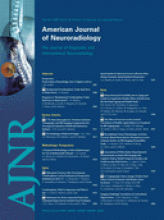Sinus histiocytosis with massive lymphadenopathy (SHML), described by Rosai and Dorfman, is a rare histoproliferative disease that classically presents with painless bilateral cervical lymphadenopathy in 83% of patients.1 Extranodal disease is rare whereas isolated central nervous system involvement is exceptional; there are fewer than 40 reported cases, of which only 4 are described in the pediatric population.2 Pathogenesis has not been established; however, most theories implicate an aberrant response to an as-yet-uncharacterized antigen, possibly an infectious organism.3 The imaging characteristics of SHML are not pathognomonic, but instead, prompt a differential diagnosis that includes lymphomatous, pseudolymphomatous, neoplastic, and infectious conditions. Histologic examination is characterized by S-100 protein, CD68 immunoreactive histiocytes, and emperipolesis.3 Treatment of choice is dependent on the location of greatest disease burden; however, with intracranial disease, surgery is the standard of care.4 We describe the youngest known case of isolated intracranial SHML presenting initially as forehead discoloration secondary to a large supratentorial mass in a 2-year-old girl.
A 28-month-old girl presented to her pediatrician after a 2-month history of her “forehead turning blue whenever she cries.” Physical examination revealed bilateral papilledema with forehead discoloration. The erythrocyte sedimentation rate was abnormal (106 mm/first hour; reference, 0–13). CT and MR imaging were performed (Figs 1⇓–3). Bifrontal craniotomy revealed a large encapsulated firm extra-axial mass with small pockets of purulence filled with serous material, which correlated with the MR imaging findings. The mass was predominantly solid and fibrous. Histologic examination of the mass showed a proliferation of histiocytic cells with cleaved-grooved nuclei, eosinophilic cytoplasm, and emperipolesis. The histiocytes were immunoreactive for CD68 and S-100 protein and were negative for CD1a.
Noncontrast CT, axial image, reveals a large predominantly hyperattenuating parafalcine mass with central low attenuation, extending to the frontal convexity, exhibiting mass effect and associated vasogenic edema.
Axial T1- (left) and T2-weighted (right) images demonstrate a large heterogeneous extra-axial perafalcine mass extending to the frontal convexity, exhibiting mass effect on the medial frontal lobes and corpus callosum, with considerable associated frontal lobe vasogenic edema. The mass has T2-weighted hypointense components.
Axial (left) and coronal (right) T1-weighted postcontrast images. The mass enhances heterogeneously after contrast administration and demonstrates multiple cystic areas both within and adjacent to it.
This child is the youngest known case of intracranial SHML, and the case is exceptional both because of the age at presentation and the strikingly advanced burden of disease. The clinical course emphasizes the long-standing and relatively indolent nature of the condition. The seemingly protean imaging characteristics described in the literature are largely based on disparate intracranial locations. Generally, as in this case, the CT features are of a predominantly homogeneously attenuating dural-based extra-axial mass associated with adjacent bony erosion. Similarly, on MR imaging, the masses are largely hypo- to isointense on T1-weighted imaging with very low signal intensity on T2-weighted imaging.3 However, in our patient, there were atypical features that complicated the differential diagnosis, including small cystic areas both adjacent to and within the lesion, which raised the possibility of infectious etiologies or rarer entities, such as a perafalcine ependymoma, which can have similar imaging characteristics and has been reported in this age group.
The definitive diagnosis is, of course, based on the distinctive histologic appearance. Management of SHML disease, particularly when vital organ compromise or debilitating clinical manifestations exist, is surgical debulking, as in our patient.4 In conclusion, sinus histiocytosis with massive lymphadenopathy is a rare but valid differential diagnostic consideration in pediatric patients presenting with an intracranial dural-based mass.
- Copyright © American Society of Neuroradiology














